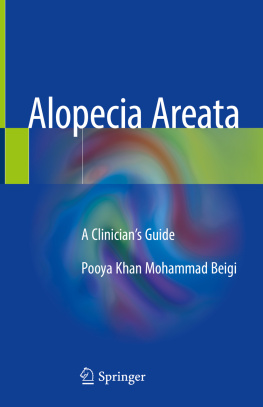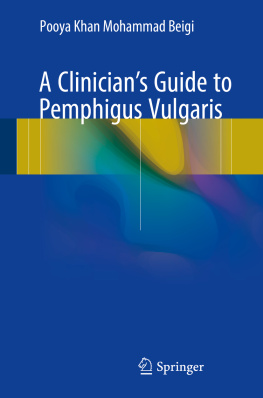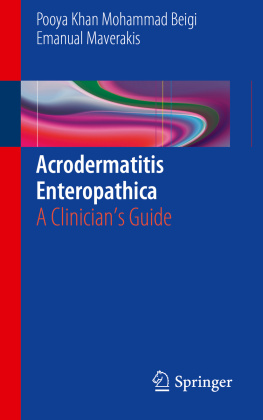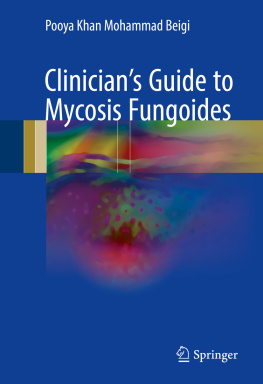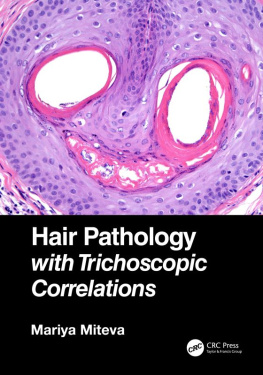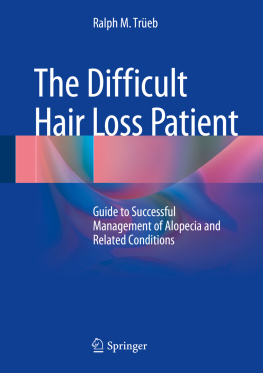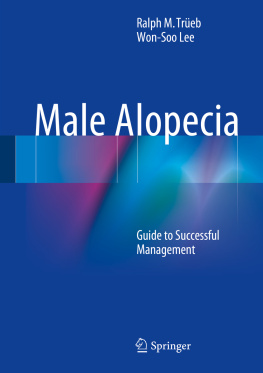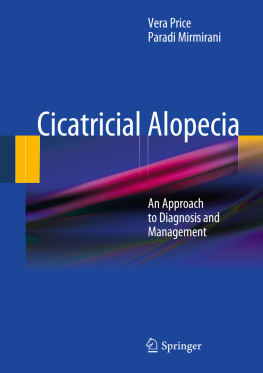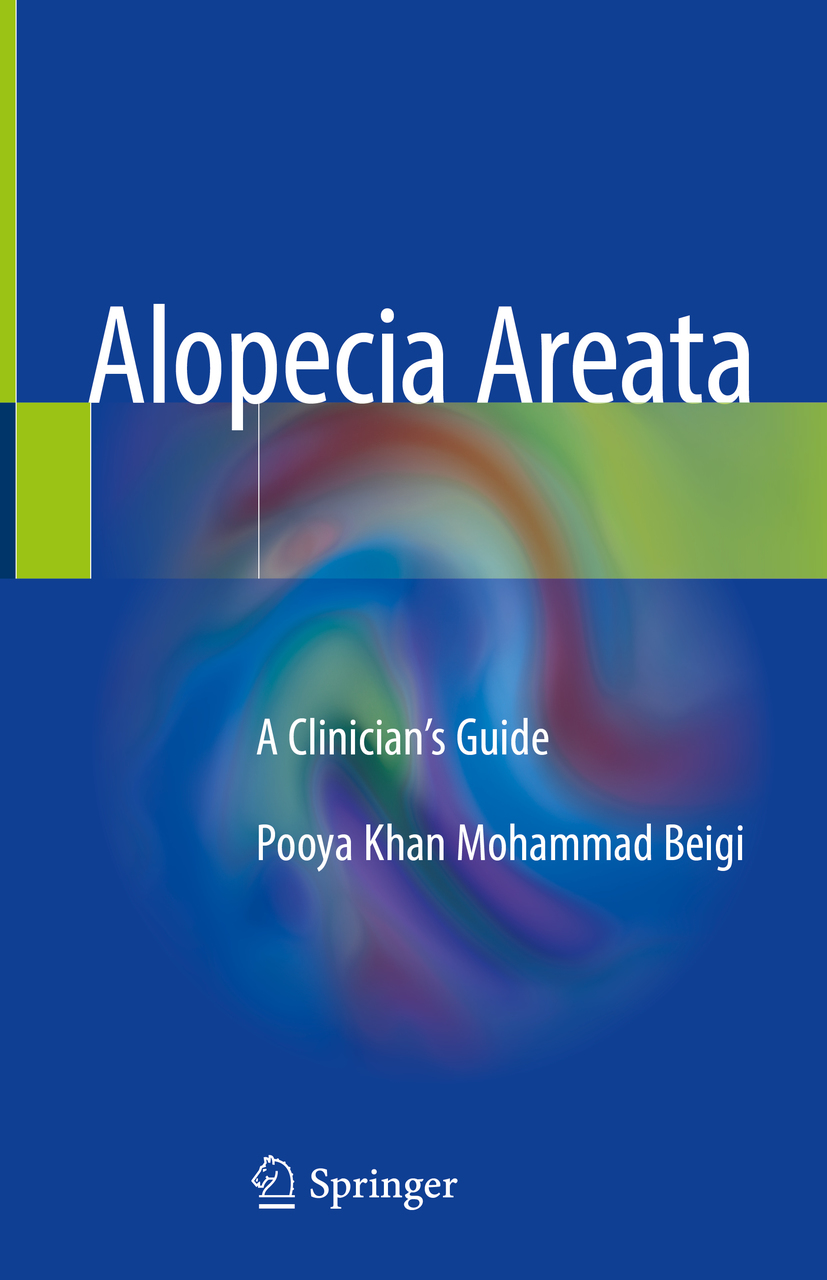Pooya Khan Mohammad Beigi
Alopecia Areata A Clinicians Guide
Pooya Khan Mohammad Beigi
Department of Health Management, New York Medical College, Valhalla, New York, USA
University of British Columbia, Vancouver, British Columbia, Canada
Misdiagnosis Association, Seattle, Washington, USA
ISBN 978-3-319-72133-0 e-ISBN 978-3-319-72134-7
https://doi.org/10.1007/978-3-319-72134-7
Library of Congress Control Number: 2018934412
Springer International Publishing AG, part of Springer Nature 2018
This work is subject to copyright. All rights are reserved by the Publisher, whether the whole or part of the material is concerned, specifically the rights of translation, reprinting, reuse of illustrations, recitation, broadcasting, reproduction on microfilms or in any other physical way, and transmission or information storage and retrieval, electronic adaptation, computer software, or by similar or dissimilar methodology now known or hereafter developed.
The use of general descriptive names, registered names, trademarks, service marks, etc. in this publication does not imply, even in the absence of a specific statement, that such names are exempt from the relevant protective laws and regulations and therefore free for general use.
The publisher, the authors and the editors are safe to assume that the advice and information in this book are believed to be true and accurate at the date of publication. Neither the publisher nor the authors or the editors give a warranty, express or implied, with respect to the material contained herein or for any errors or omissions that may have been made. The publisher remains neutral with regard to jurisdictional claims in published maps and institutional affiliations.
This Springer imprint is published by the registered company Springer International Publishing AG part of Springer Nature.
The registered company address is: Gewerbestrasse 11, 6330 Cham, Switzerland
To my real hero
Mohammad Khan Mohammad Beigi
who inspired me to achieve and succeed by focusing only ever on the goal and never on the obstacles
and
To my real teacher
Parvin Mojabi
to whom I owe my life and all that I have accomplished and become
and
To my real companion
Sherry Jalalian
who unceasingly encouraged me with her patience, without which I would not have been able to persevere in spite of my humanity
Preface
Alopecia is characterized by hair loss. Contrary to popular belief, alopecia can affect men, as well as women and children. The affected region can vary from a small area to the whole body. Currently, many etiologies have been proposed for its onset with the most likely factors being the autoimmune system, genetics, and exposure to various aspects of the environment. There are several types of alopecia with androgenetic alopecia seen among 70% of the population (Falto-Aizpurua et al. 2014). Alopecia areata, another common form of dermatitis due to an autoimmune disease, has a prevalence rate of 0.10.2% (Amin and Sachdeva 2013) and manifests as a sudden and non-scarring variety of hair loss.
Alopecia areata has a very costly impact on the diagnosed patients. These effects tend to be underestimated and simply labeled as a cosmetic issue. However, in the eyes of the patient, the impact of sudden hair loss with minimal success in treatment can be quite overwhelming. As a result, the patients quality of life is diminished due to the stigma associated with balding. Patients experience drops in self-esteem, further affecting patients abilities to regain their regular lifestyle.
Misdiagnosis of alopecia areata occurs very commonly due to the common clinical presentation between this disease and other diffuse alopecia types such as telogen effluvium and androgenic alopecia (Zhao et al. 2012). A misdiagnosed patient can go through several treatments based on the believed diagnosis and has no success in treating their hair loss. The constant failure of treatments can further impact a patients self-esteem and can prolong treatment time more than necessary. The added time is costly for the patient, physician, and healthcare system. As a result, it is extremely important to complete the thorough tests outlined in the book to properly detect and diagnose the alopecia form.
The following book is meant to be a complete overview of all the diseases associated with and commonly misdiagnosed forms of alopecia. It will provide the epidemiology, pathophysiology, diagnosis, differential diagnosis, as well as the treatments found to be the best management actions on these diseases. Due to the extensiveness of this book, it has been divided into five parts: The first part entails a very brief overview of the book. The second part introduces the varieties of diffuse alopecia, followed by the third part which focuses on the focal alopecias, both scarring and non-scarring forms. The fourth part contains two research studies completed by the authors of this book. The final part is a compilation of my patient descriptions, photos, and reported cases of alopecia meant to supplement the second and third part of the book. The ultimate purpose of this book is to educate physicians on various forms of alopecia and how to accurately diagnose patients.
This book on alopecia is simply a part of the A Clinicians Guide book series published by International Springer Publication. These books are meant to enlighten individuals about the commonly misdiagnosed diseases by providing brief descriptions, causes, and treatments associated with a particular category of disease. As of the moment, there are three other published books in this series: A Clinicians Guide to Mycosis Fungoides , Acrodermatitis Enteropathica: A Clinicians Guide , and A Clinicians Guide to Pemphigus Vulgaris (see the last two references for details).
This series is meant to prevent common misdiagnoses from occurring by educating physicians about the associated diseases. The books are created with the help of the Misdiagnosis Association based in Seattle, USA. The aim of the association is to gather and accumulate cases in regard to misdiagnosed cases to create a useful database for physicians to improve the healthcare system.
It is my hope that this book will be a significant step in enhancing the knowledge of physicians, medical students, and other healthcare providers involved in the diagnosis and treatment of all types of alopecia.
References
Amin S, Sachdeva S. Alopecia areata: A review. J Saudi Soc Dermatol & Dermatol Surg. 2013;17(2):3745. https://doi.org/10.1016/j.jssdds.2013.05.004 .
Falto-Aizpurua L, Choudhary S, Tosti A. Emerging treatments in alopecia. Expert Opin Emerg Drugs. 2014;19(4): 54556. https://doi.org/10.1517/14728214.2014.974550 .
Zhang X, Zhang B, Caulloo S, Chen X, Li Y, Zhao Y. Diffuse alopecia areata is associated with intense inflammatory infiltration and CD8+ T cells in hair loss regions and an increase in serum IgE level. Indian J Dermatol Venereol Leprol. 2012;78(6):709. https://doi.org/10.4103/0378-6323.102361 .

